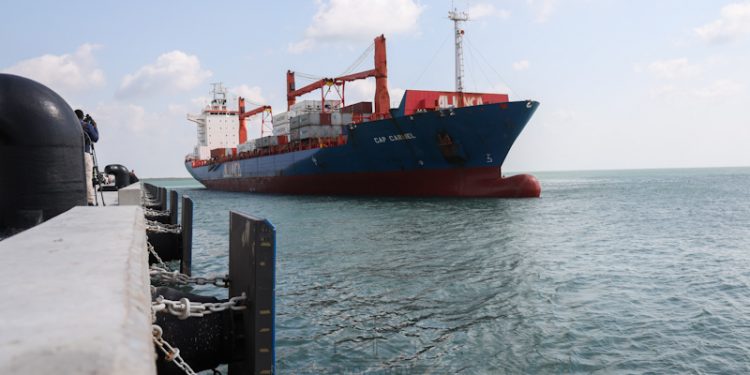Kenya and the Netherlands are set to commence importation of flowers from Kenya using the new Lamu port as the gateway. This provides a boost to the facility that was operationalized in May 2021. Netherland’s ambassador to Kenya Maarten Brouwer revealed this when he visited Lamu this week.
Lamu is emerging as a critical cog in the direct export of the cargo to Europe. Following the launch, Kakuzi PLC celebrated the operationalization of the new Lamu port with an inaugural 80-ton cargo of avocados that was destined for France. Avocados grown at the Kakuzi PLC Makuyu orchards were part of the cargo loaded on the MV Seago Bremerhaven which docked at the port of Lamu.
According to Kakuzi MD Chris Flowers, the port will provide wider benefits for agribusiness firms that import farm inputs and export produce.
“As a truly Kenyan agribusiness firm, we are excited at the operationalization of the first berth at the Port of Lamu. This development begins to crystallize the Lamu Port-South Sudan-Ethiopia-Transport Corridor project, which will benefit Kenyan producers immensely and congratulate the Government and the Kenya Ports Authority among the other development partners for this milestone.”
The Netherlands is the world’s third-largest exporter of cut flowers, Kenya sells 70 percent of its flowers to Europe, which includes the Netherlands. The horticultural sector is Kenya’s third-largest foreign exchange earner with the flower industry directly employing 150,000 people and contributing 1 percent of the country’s GDP.
The envoy to Lamu said the Netherlands has an open economy that depends heavily on foreign trade and investment. Netherlands imports from Kenya an average of $35 million worth of flowers a month.
Kenya exports mainly horticultural produce to the European country, in particular, cut flowers. Besides flowers, other exports to the Netherlands include tobacco, vegetables, and fruits.
Lamu port has in recent months turned into a major player in the transshipment business as it has attracted several vessels since the launch. Transshipment is the movement of goods or containers to an intermediate destination, then to another destination, with among reasons being to change the means of transport during the journey, known as transloading.
Two months ago, the Kenya Ports Authority (KPA) General Manager in charge of Lamu Port, Engineer Abdullahi Samatar, said the arrival of these ships signifies that Lamu Port is ready for business.
“We expect more transshipment traffic to this port which has a competitive advantage in terms of geographical position and capacity to handle bigger vessels,” Eng. Samatar said.
Its berths are 400 meters long compared to the other port in Kenya – Mombasa’s 300 meters average while the depth at Lamu is up to minus 17.5 meters against 15 meters at the Port of Mombasa.
The Kenyan Government has invested KSh 40 billion in constructing the initial three berths of the planned 23-berth facility.
The port has the capacity to handle ships with a carrying capacity of up to 12,000 TEUs, compared to the 8,000 to 10,000 TEUs carrying capacity vessels that are calling at the Port of Mombasa.
Lamu can handle Post-Panamax ships. These vessels cannot pass the Panama Canal, with the word Post-Panamax being used to describe the world’s biggest vessels.
Its natural depth and proximity to the open sea make it potential for transshipment as it will attract larger vessels that cannot dock at Mombasa, according to the Shippers Council of Eastern Africa (SCEA).
“Kenya can become a major player for transshipment and maritime trade. The government should give space to shipping lines to put up berths. This way, they will guarantee business,” SCEA Chief Executive Gilbert Langat told the local press.
The opening of the Lamu port sets the stage for the competition with the Port of Durban, the largest and busiest shipping terminal in sub-Saharan Africa which has been enjoying huge transshipment business.
Lamu has the proximity of handling cargo between ports in Tanzania, South Africa, the Middle East, Europe, and Oman’s Port of Salalah.
More shipping lines are slowly warming up for the use of Lamu Port, among them include the world’s largest container shipping companies ― Maersk and CMA CGM.
Known as Maersk A/S, the Danish business conglomerate with activities in the transport, logistics, and energy sectors, is a regular shipping liner at Mombasa and is said to be keen to be calling at Lamu. It has in recent years invested immensely in other services to create a full value chain logistics service.
Hapag-Lloyd, which is among the top 10 shipping lines in the world, in terms of volumes, is also looking at the possibilities of using the new port.
According to Hapag-Lloyd country manager Prashant Sindhwani, Lamu Port has potential for transshipment business, even as it provides a new transit route for Ethiopia and South Sudan destined cargo.






